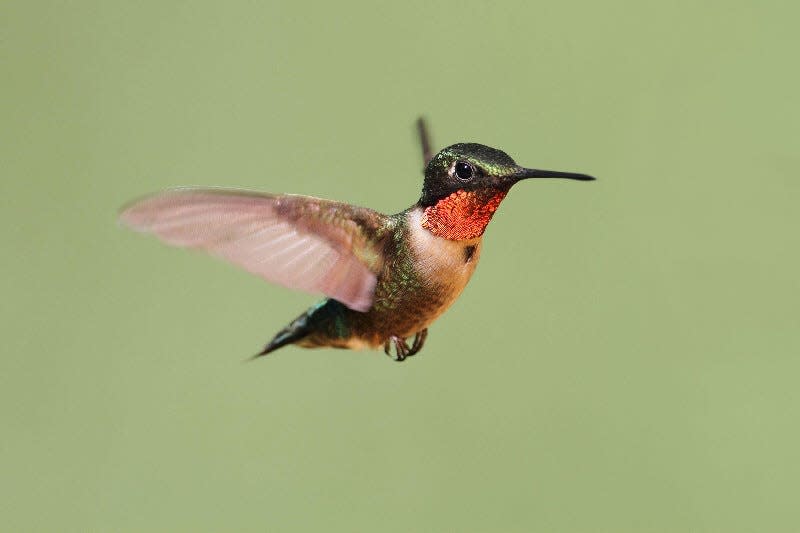Hummingbird season is approaching. Here's how to attract them to your feeder
Hummingbirds are about to make their annual spring migration up the East Coast, meaning birdwatchers will soon be able to attract, feed and gaze at the wildly colorful bird.
"Ruby-throats arrive in Pennsylvania in late April and May, with males preceding females by a week or two," read a portion of the Pennsylvania Game Commission's fact sheet on the ruby-throated hummingbird. "The timing of arrival seems to coincide with the blooming of wild columbine, but the availability of flying insects and flowing sap are probably important also."
Here's the birdwatcher's guide on how to recognize the ruby-throated hummingbird, and ways to entice them to your yard.

Spotting a hummingbird
The ruby-throated hummingbird is aptly named, due to its bright coat and contrasting throat patch.
"The male sports a bright metallic-red gorge, or throat patch; on the female this area is grayish white," read the game commission's factsheet. "The bill is long and thin. The legs are short, and the feet are small, designed for perching rather than for walking or hopping."
Analysis: Bucks County's bird population Is our once booming bird population beginning to dwindle in the northeastern United States?
Additionally, male and female hummingbirds have glistening green-bronze backs and pale stomachs.
The hummingbird gets its name because the beat of its wings ― more than 50 times per second ― creates a humming sound.
Spring migration path of hummingbirds
The hummingbird is one of a dozen species which breed and spend summers in the U.S. and Canada, but the only species whose habitat is east of the Mississippi River. On occasion, a lost bird ― most often a rufous hummingbird ― is confirmed visiting the Northeast.
The copper-colored rufous is the species which travels the farthest north with a range extending into Alaska.
Its normal migration includes the eastern slopes of the Rockies and into the Great Plains. It is only an occasional visitor east of the Appalachians.
"Many hummingbirds spend the winter in Central America or Mexico, and migrate north to their breeding grounds in the southern United States as early as February, and to areas further north later in the spring," read a portion of the 2024 ruby-throated hummingbird guide at Hummingbird Central. "Research indicates a hummingbird can travel as much as 23 miles in one day. However, during migration as they cross the Gulf of Mexico they may cover up to 500 miles at a time. Their average speed in direct flight is in the range of 20-30 mph."
Your hummingbird feeding primer: When to put out your hummingbird feeders this spring and where to put them
How to attract hummingbirds
Getting a proper hummingbird feeder will do the heavy-lifting for anyone looking to attract the migrating bird.
While the warm weather does allow for early hatching of small insects, a major part of the tiny birds' diet, experts say hummingbird feeders can be put out early so they are available for the males, the first of the migrants to arrive.
A dominant bird often will perch on a branch near a feeder or flower patch, watching for intruders also looking for a sip of nectar.
Hummingbird Central noted that feeders come in different sizes and are made from a variety of materials, but there are differences birdwatchers should be aware of.
"Some feeders are acrylic, and some glass. The plastic ones are lighter and not subject to breakage, but may contain BPA," read Hummingbird Central's guide. "However, many prefer glass hummingbird feeders and their long-term durability as opposed to plastic, which can warp, fade and crack over time. And sometimes glass is easier to clean than plastic.
"Whatever feeder you prefer, make sure that it has adequate red color to be visible to the hummingbird from a distance."
Bird-watching at the Silver Lake Nature Center
Bird watchers can get a jump on the season by joining the saturday morning bird walks at the Silver Lake Nature Center.
The bird watch walks will be held every Saturday, beginning on March 2, and going through May. The Silver Lake Nature Center also runs similar bird-watch walks From September through November.
Bird watchers will meet at 7:30 in front of the center, at 1306 Bath Road in Bristol.
Participating in this walk is free.
This article originally appeared on Bucks County Courier Times: Hummingbirds making their way to PA and how to attract them

